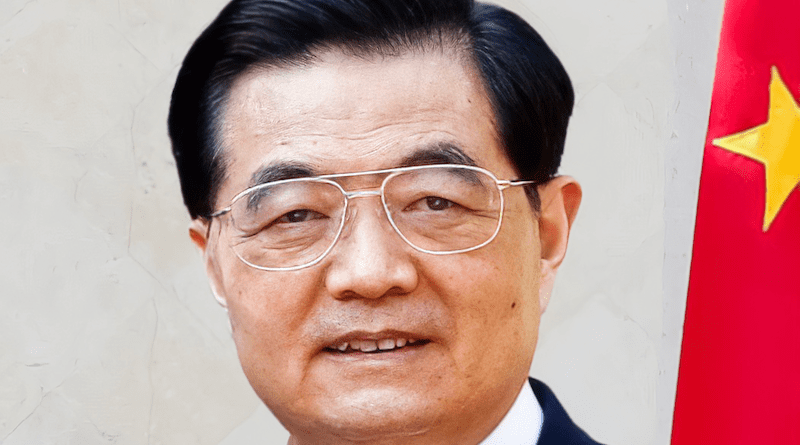China: Points To Ponder On Hu Jintao’s Unceremonious Ouster From CPC Congress – Analysis
China’s former President Hu Jintao could claim credit for Xi Jinping’s signature policies, thus diminishing Xi’s bid to go down in history as an innovator on par with Mao Zdong.
The unceremonious and publicized removal of the former Chinese President Hu Jintao from the hall in Beijing at which the Chinese Communist Party was holding its final session on Saturday, and the stoic indifference shown by Xi Jinping and other leaders to the spectacle happening in their midst, were meant to signal to the party and the Chinese public that Xi would not tolerate anyone who could challenge his claims.
According to the Western media, Hu is a liberal and a democrat in contrast to Xi, and that he could be a potential ideological challenger on that account. But a study of Hu’s tenures as General Secretary of the CPC and President of China by Rush Doshi, founding director of the Brookings China Strategy Initiative, shows that Hu isn’t liberal and non-aggressive and that, actually, he was the author of many key policies now associated with Xi. Doshi says that Xi’s major military, economic, and political investment policies have their roots in the tenure of Hu Jintao as General Secretary of CPC from November 2002 to November 2012 and President of China from March 2003 to March 2013.
(see Rush Doshi, https://www.brookings.edu/articles/hus-to-blame-for-chinas-foreign-assertiveness/).
Thus, Xi could well see Hu as a threat. Leaders who are eager to consolidate their power, tend to discard former associates who could make claims challenging their uniqueness/supremacy. This is the reason why a new leader typically wipes the slate clean of former associates and inducts handpicked new ones who have no claims challenging him.
Xi Jinping did push through a dramatic military reorganization. But other landmark policies attributed to him (including China’s turn to a blue-water navy) began well before his leadership, Doshi says.
“Indeed, it was President Hu’s administration that inaugurated China’s shift away from two decades of anti-access/area-denial capabilities that were intended to complicate US intervention in favor of a new emphasis on power projection and amphibious capabilities.”
“In 2003, nine years before Xi assumed leadership, President Hu announced China’s Malacca Dilemma and suggested China needed the blue-water capabilities to protect the sea lines upon which it depends. The next year, he tasked the navy with new historic missions away from China’s shore. After the global financial crisis, Hu committed resources to these goals.”
“In 2009, the Politburo Standing Committee reportedly approved work on refitting the former Soviet-carrier Varyag into a Chinese aircraft carrier. Not long after, China began plans to construct a second and third carrier and to accelerate production lines on surface vessels.”
“It was Xi’s predecessor Hu, who announced the goal of becoming a maritime great power, fulfilling missions in the far seas, and securing Chinese overseas interests and took action to get there,” Doshi adds.
The Brookings China scholar acknowledges that the Belt and Road Initiative (BRI) bears Xi’s signature. But he points out that many of the high-profile projects now subsumed under BRI, began before Xi’s tenure under Hu’s “going out” policy. This policy produced port projects in Pakistan, Sri Lanka, Myanmar, and Malaysia.
“The very of idea of using infrastructure to bind neighbors to China was part of Hu’s important 2009 address,” Doshi recalls.
In 2009, anticipating BRI, Hu had declared that China must actively participate in, and vigorously promote, the construction of highways, railways, communications, and energy channels in the neighborhood “to form a network of interconnected and interoperable infrastructure around China.” Xi has this objective as an inheritance from Hu Jintao.
Going further, Doshi says that major Chinese multilateral initiatives, including the launch of the Asia Infrastructure and Investment Bank (AIIB) and China’s leadership of the regional Conference on Interaction and Confidence Building in Asia (CICA) had their antecedents in Hu’s tenure as President.
“The AIIB was first proposed by the Central Party Research Office in 2009, discussed at the Bo’ao Forum that year, and then apparently approved for implementation at the 18th Party Congress when Hu was still the paramount leader, though admittedly Xi may have made the final decision,” Doshi says.
Xi’s tough territorial expansion policy also owes its origin to Hu. In his 2009 Ambassadorial Conference address, Hu had called for a firmer line on territorial claims.
“China’s subsequent handling of disputes in the East and South China Sea—including the 2009 U.S. Impeccable incident, the 2010 collision between Chinese and Japanese vessels, and the 2012 purchase of the Senkaku Islands by the Japanese government presaged a more assertive policy,” Doshi says.
“When these actions are combined with Hu’s authoritative remarks, the conclusion is that China’s trajectory on regional disputes was moving in a hawkish direction before Xi assumed power, well before he assumed the leadership of the Maritime Rights Protection Leading Small Group.”
“It seems reasonable to assume that even if Xi had not assumed power, China would have still pushed to consolidate its territorial interests under a different leader,” Doshi points out.
Bundled out of the CPC conference hall on the plea that he was ill, Hu has been thrown out of the Chinese power elite in the most humiliating way. Not surprisingly, his protégé Li Keqiang, is no longer Prime Minister.

